Creating and Implementing Parameters Fields
The process of using parameter fields in reports includes two distinct steps:
- Creation of the parameter field.
- Implementation of the parameter field into the report.
The remainder of this chapter uses the example mentioned earlier, the World Sales Report, to create and implement parameter fields into a report. The World Sales Report is one of the many sample reports that are provided by the Crystal Reports installation.
Reviewing Parameter Field Properties
Before you learn how to create and implement parameter fields, it is useful to understand a few common properties associated with creating parameter fields. Each of the following properties is presented within the Create/Edit Parameter Field dialog, shown in Figure 5.2:
- Name A logical name for the parameter field.
- Prompting Text A statement or question that is presented to the business user within the report prompt dialog for the parameter field.
- Value Type A list of available field types that correspond to how you want to use the parameter field within the report, including String (the default option), Boolean, Currency, Date, Date Time, Number, and Time.
- Allow Multiple Values Enables the business user to enter more than a single value for the parameter field.
- Discrete Values Enables the business user to enter only a single value for the parameter field.
- Range Values Enables the business user to specify a range, using start and end values, for the parameter field.
- Discrete and Range Values Enables the business user to enter specific single values as well as a range, using start and end values, for the parameter field.
- Allow Editing of Default Values Enables the business user of a report to edit any default values provided in the report parameter dialog or add their own manually.
- Default Values A dialog that enables the report designer to specify default parameter values based on either a database field, external pick list, or manual entries.
Figure 5.2. The primary parameter field properties are presented within the Create/Edit Parameter Field dialog.

Now that you have been exposed to the primary parameter field properties, you will use these items while creating parameters for a World Sales Report, as referenced earlier in the chapter.
Creating Parameter Fields
The first step in using parameters within a report is to create the actual parameter field and define the primary properties associated with it. In the following exercise, use the Field Explorer dialog to create two new parameter fields for the World Sales Report:
- A manual text entry field to use as the report's title
- A database field that prompts the business user to select one or more countries and use this selection to filter the data returned for the report
To begin your exercise, open the World Sales Report within the Crystal Reports designer. This sample report should be installed in the following directory, unless you have chosen an alternative location for the sample reports during the Crystal Reports 10 installation process:
C:Program FilesCrystal DecisionsCrystal Reports 10SamplesEnReportsGeneral Business
After you have opened this sample report, you can begin the steps necessary to create the parameter field objects in the following way:
- Remove the existing report title text object. After you have opened the World Sales Report, navigate to the Design tab view, highlight and delete the text object currently used as the report's title that reads World Sales Report, located in the Report Header A section. Use your parameter field to populate the report title.
- Remove the current Top N sort order because it is not needed for your exercises. From the Report menu, select Group Sort Expert, and within the presented dialog modify the For This Group Sort: drop-down setting to display All as shown in Figure 5.3. Click OK to continue.
Figure 5.3. Use the Group Sort Expert dialog to remove the Top N sort order from the report.
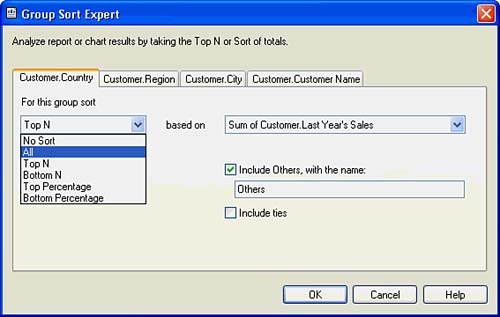
- Open the Field Explorer dialog by either clicking the appropriate toolbar button or using the View menu.
- Open the Create Parameter Field dialog. To do this, right-click on Parameter Fields within the Field Explorer and either select New from the pop-up menu or click on the New button at the top of the Field Explorer.
TIP
In addition to using the right-click menu to create a new parameter field, you can use the Field Explorer's toolbar commands to create, edit, rename, and delete parameter fields. The operations available on this toolbar depend on what you have selected in the Field Explorer dialog.
You first create a manual text-entry parameter field to enable the business user to define a title to display on the report.
- Define the key properties for the parameter object. Within the Create Parameter Field, enter Title in the Name property, and provide a meaningful prompting text so that the business user understands how the entered value is used, such as, Enter a title to be used for this report.
- Select Discrete Values under the Options area and click OK to return to the Field Explorer.
- You should now see the Title parameter field listed under Parameter Fields in the Field Explorer, as shown in Figure 5.4.
Figure 5.4. The Field Explorer is used to access, edit, and create parameter fields.
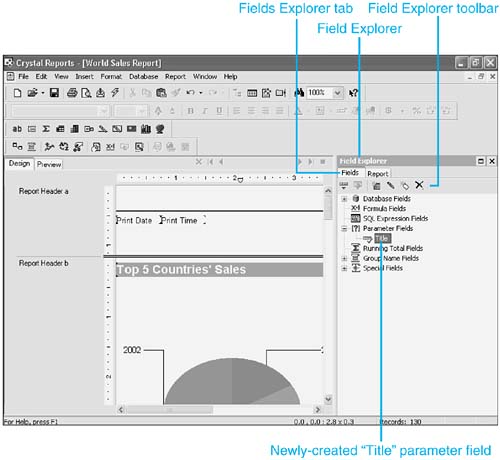
You now create a second parameter field to use later in the chapter when discussing how to use parameter fields in coordination with record selections. In this way, you can filter the report data according to the selected parameter values.
- Open the Create Parameter Field dialog. To do this, highlight the Parameter Fields item and click the New toolbar button inside the Field Explorer dialog.
- Define the key properties for the parameter object. Within the Create Parameter Field dialog, enter Countries in the Name property and provide a meaningful prompting text so that the business user understands how the entered value will be used, such as, Please select one or more countries for this report.
- Select both the Allow Multiple Values and Discrete Value(s) items under the Options area, as shown in Figure 5.5.
Figure 5.5. Use the Create Parameter Field dialog to create and edit parameter fields.
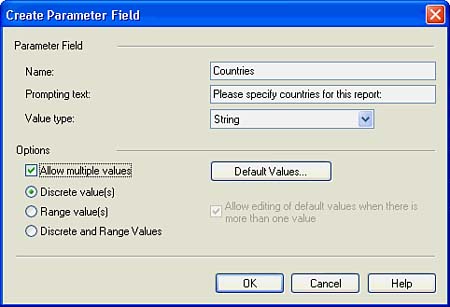
Setting Default Values for Parameter Fields
You now want to define the Countries parameter field to include all database values within the Country field of the Customer table. Map the parameter field to this database field and quickly import these values, enabling the business user of the report to select one or more country values from the available list.
When setting default parameter values, a list of default values can be read from the database or entered manually to provide the business user with a list of available values from which to choose. The Crystal Reports application enables you to define the default values list only when you are designing reports, and no direct database connection exists to populate the prompting parameter field list when the business users run the report. The following is an overview of various options available within the Set Default Values dialog to make data entry easier for the business users:
- Browse Table The database table that contains the default values for the parameter field.
- Browse Field The database field that contains the default values for the parameter field.
- Select or Enter Value Used to enter values in the Default Values list. You can type new values in the entry box and then click the Add button (>), or select a value from the list and then click the Add button (>). This list is automatically populated when a field is selected through the Browse Field drop-down box.
- Add, Add All Used to move one (>) or all (>>) values from the Select or Enter Value to Add list (on the left) to the Default Values list (on the right).
- Remove, Remove All Used to move one (<) or all (<<) values from the Default Values list (on the right) back to the Select or Enter Value list (on the left).
- Import/Export Used to import or export a text file containing a pick list of parameter values to be used as the default values. (Note: These two buttons are not available when creating or editing parameters in the OLAP Report Creation Wizard.)
- Default Values and Description The list of values displayed when business users are prompted to populate the parameter field, and a description for each value (optional). To set the optional description for each default value, use the Set Description button and corresponding dialog, located just below the Default Values list. The value list can be populated from any database table included in the report using the Browse Table and Field drop-down boxes. The description can be used to create a more user-friendly label for the business users. For example, the Country field could have been stored as a number in the database, but it would be more intuitive for the user to select it by name.
- Display Controls whether the prompt to business user displays the Value and Description, or just the Description, for each default value. In either case, only the Value is used within any database interaction, such as with record selection definitions.
- Order The order that the default values are displayed in the prompt to the business users of the report.
- Order Based On The order of the default values can be based on either the Value or Description property of these values.
- Length Limit The minimum and maximum length limits for the parameter field.
- Edit Mask Used to enter an Edit Mask for string data types rather than specifying a range of values. The Edit Mask can be any of a set of masking characters used to restrict the values you can enter as parameter values. (The Edit Mask also limits the values you can enter as default prompting values.) Table 5.1 provides a listing of the masking characters and instructions on how to use them.
Table 5.1. Edit Mask Characters
Mask Character
Mask Description
A
Requires entry of an alphanumeric character for its place in the parameter value.
a
Enables an alphanumeric character but does not require the entry of a character for its place in the parameter value.
0
Requires a digit (0 to 9) for its place in the parameter value.
9
Enables a digit or a space but does not require such an entry for its place in the parameter value.
#
Enables a digit, space, or plus/minus sign, but does not require such an entry for its place in the parameter value.
L
Requires a letter (A to Z) for its place in the parameter value.
?
Enables a letter but does not require such an entry for its place in the parameter value.
&
Requires a character or space for its place in the parameter value.
C
Enables any character or space but does not require such an entry for its place in the parameter value.
., : ; - / (separator characters)
Inserting separator characters into an Edit Mask is akin to hard-coding the formatting for the parameter field. When the field is placed on the report, the separator character appears in the field object frame, like this: L0L-0L0. This example depicts an edit mask for a Canadian Postal Code (such as M2M-2L5) with a forced display dash.
< or >
Forces subsequent characters in the parameter to be converted to lowercase (<) or uppercase (>).
Forces the subsequent character to be displayed as a literal.
Password
Enables the setting of the Edit Mask to "Password," so that subsequent conditional formulas can specify that certain sections of the report become visible only when certain user passwords are entered.
You now define the default values for your parameter fields (if necessary, refer to the list of options within the Set Default Values dialog while completing these steps):
- Access the Create/Edit Parameter dialog if you have closed it by highlighting the Countries parameter and clicking on the Edit toolbar button. Open the Set Default Values dialog by clicking on the Set Default Values button, as shown in Figure 5.6.
Figure 5.6. The Set Default Values dialog enables you to define the default values for parameter fields.

- Choose the database table and field from which to set the defaults. Under the Select from Database area of the Set Default Values dialog, select Customer from the Browse Table list, and then select Country from the Browse Field list.
- Add the actual database values to the default value list. With all the country values listed under the Select or Enter Value to Add area on the left, use the Add All (>>) button to move all these values to the Default Values list on the right, as shown in Figure 5.6.
Continuing the steps started above, now add descriptions to the default values that you have added to the parameter field.
- Locate and highlight the USA value in the Default Values list. Click on the Define Description button located just below the Default Values list to present the Define Description dialog.
- Add United States of America as the description for USA, as shown in Figure 5.7, and click OK to close the Define Description dialog. If you want, repeat this step for any additional default values.
Figure 5.7. The Define Description dialog enables you to create user-friendly descriptions for parameter selections that can be presented to users instead of potentially cryptic database values.
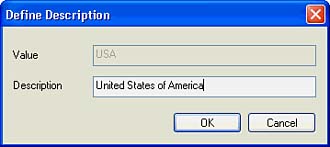
To make the default values friendlier to the business users of the report, you can sort the contents of the display prompt lists based on the Order and Order Based On option settings. Seven distinct options are available to sort the parameter field values that are reflective of the parameter value type, including both ascending and descending for the three data typesalphanumeric, numeric, and date/timeas well as No Sort. Continuing the Parameter Creation example, follow these steps:
- Sort the Country parameter field in alphabetic order. Select Alphabetical Ascending from the Order drop-down list, and choose Value from the Order Based On list, as shown in Figure 5.6.
TIP
If you select a sort type from the Order list that does not match the parameter field value type, no sorting is applied.
- For your purposes here, you can leave the remaining options within the Default Values dialog to their default state and click OK to return to the Create Parameter Field dialog. If desired, peruse the overview of default setting options and use these to modify the desired options for your parameter field.
- Click OK to return to the Field Explorer. You should now see the Countries parameter field listed under Parameter Fields in the Field Explorer.
TIP
There are a few considerations to keep in mind when working with parameter fields, such as
- Any parameter field prompting text more than one line in length will automatically word wrap.
- The creation of a pick list enables the business user to select parameter field values from drop-down boxes instead of needing to enter them manually.
- A parameter field does not have to be placed in a report to be used in a record or group selection formula. You can create the parameter field and then enter it in your formula as you would any other field.
Implementing Parameter Fields
You have now completed the first task necessary to use parameter fields within a reportcreating the actual parameter field objects. This section, and the exercises included here, discuss how to apply these parameter fields and make use of them to provide the business user of the report with a more dynamic and interactive reporting experience.
First, implement the parameter field created earlier, called Title, to serve as the title to the report. This example demonstrates how a manual text entry field can be used to add useful commentary or descriptive information to a report. Continue working with the same report, the World Sales Report and follow these steps:
- Add and position the Title parameter object onto the report. Open the Field Explorer dialog and expand the Parameter Fields list. Click on the Title parameter field, drag it onto the report, and drop it into the upper-left corner of the Report Header A section, shown in Figure 5.8 in a size 20 Arial font.
Figure 5.8. Drag and drop the Title parameter field into the upper-left corner of the Report Header A section.
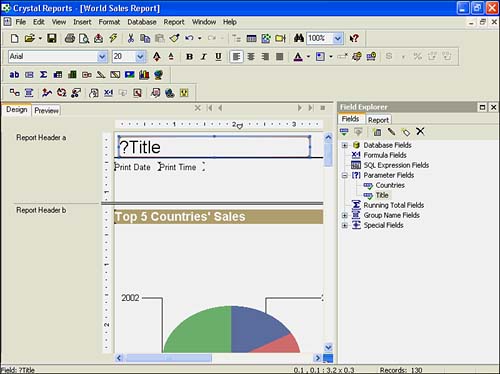
- Preview the report. To view how this parameter is now used within the generation of the report, run the report by clicking on the Refresh toolbar button (represented by the lightning bolt icon). As shown in Figure 5.9, the report now prompts the business user to enter a value that will be used as the report's title.
Figure 5.9. Parameter fields offer a means to add additional interactivity for the business users within the report.
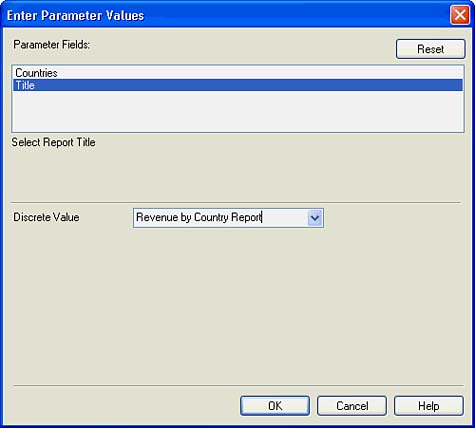
NOTE
If you have already run the report at least once and then select to refresh the report, you will also see the Refresh Report Data dialog that asks you to select from the following two options:
- Use Current Parameter Values
- Prompt for New Parameter Values
To enter or select new values for any existing parameter fields, you need to select the second optionPrompt for New Parameter Values.
Part I. Crystal Reports Design
Creating and Designing Basic Reports
- Creating and Designing Basic Reports
- Introducing the Crystal Reports Designer
- Understanding Data and Data Sources
- Introduction to the Data Explorer
- Adding Database Objects to Your Report
- Joining Database Objects Together
- Understanding the Different Join Types
- Using the Report Creation Wizards
- Understanding the Crystal Reports Gallery
- Using the Standard Report Creation Wizard
- Creating a Report Without Wizards
- Troubleshooting
Selecting and Grouping Data
- Selecting and Grouping Data
- Introduction
- Understanding Field Objects
- Working with Groups
- Understanding Drill-down Reports
- Troubleshooting
Filtering, Sorting, and Summarizing Data
- Filtering, Sorting, and Summarizing Data
- Introduction
- Filtering the Data in Your Report
- Learning to Sort Records
- Working with the Sort Expert
- Creating Effective Summaries
- Troubleshooting
Understanding and Implementing Formulas
- Understanding and Implementing Formulas
- Introduction
- Using the Formula Workshop
- Using the Workshop Formula Editor
- Creating Formulas with the Formula Expert
- Using the Formula Extractor to Create Custom Functions
- The Multi-Pass Reporting Process of the Crystal Reports Engine
- Troubleshooting
Implementing Parameters for Dynamic Reporting
- Implementing Parameters for Dynamic Reporting
- Introduction
- Understanding the Value of Parameters
- Creating and Implementing Parameters Fields
- Using Parameters with Record Selections
Part II. Formatting Crystal Reports
Fundamentals of Report Formatting
- Fundamentals of Report Formatting
- Introduction
- Positioning and Sizing Report Objects
- Modifying Object Properties for Formatting Purposes
- Exploring the Format Editor Dialog Common Options
- Combining and Layering Report Objects
- Configuring Report Page and Margin Properties
Working with Report Sections
- Working with Report Sections
- Introduction
- Formatting Report Sections
- Modifying Report Section Properties
- Using Multiple Report Sections
- Troubleshooting
Visualizing Your Data with Charts and Maps
- Visualizing Your Data with Charts and Maps
- Introduction to Charts and Maps
- Using the Chart Expert
- Using the Map Expert
- Modifying Chart and Map Properties
- Troubleshooting
Custom Formatting Techniques
- Introduction
- Making Presentation-Quality Reports
- Common Formatting Features
- Conditional Formatting Using Data to Drive the Look of a Report
Part III. Advanced Crystal Reports Design
Using Cross-Tabs for Summarized Reporting
- Using Cross-Tabs for Summarized Reporting
- Introduction to Cross-Tabs
- Benefits of Cross-Tabs
- Using the Cross-Tab Wizard
- Using Top N with Cross-Tabs Reports
- Using Advanced Cross-Tab Features
Using Record Selections and Alerts for Interactive Reporting
- Using Record Selections and Alerts for Interactive Reporting
- Creating Advanced Record Selection Formulas
- Adding Alerting to Your Reports
- Performance Monitoring and Tuning
Using Subreports and Multi-Pass Reporting
- Using Subreports and Multi-Pass Reporting
- Understanding Subreports
- Understanding Linked Versus Unlinked Subreports
- Considering Subreport Execution Time and Performance
- Using Variables to Pass Data Between Reports
- Emulating Nested Subreports
- Troubleshooting
Using Formulas and Custom Functions
- Using Formulas and Custom Functions
- Becoming More Productive with Formulas
- Choosing a Formula Language: Crystal Versus Basic Syntax
- Using Brackets in Formulas
- Using Characters in Formulas
- Recent Improvements to Formulas
Designing Effective Report Templates
- Designing Effective Report Templates
- Understanding the Importance of Reuse in Reporting
- Understanding Report Templates
- Using Report Templates
- Using Existing Crystal Reports as Templates
- Understanding How Templates Work
- Creating Useful Report Templates
- Using Template Field Objects
- Using Report Templates to Reduce Report Creation Effort
- Applying Multiple Templates
Additional Data Sources for Crystal Reports
- Additional Data Sources for Crystal Reports
- Understanding the Additional Crystal Reports Data Sources
- Connecting to COM-based Data Sources
- Connecting to Java-based Data Sources
- Understanding Solution Kits for Crystal Enterprise
- Troubleshooting
Multidimensional Reporting Against OLAP Data with Crystal Reports
- Multidimensional Reporting Against OLAP Data with Crystal Reports
- Introduction to OLAP
- OLAP Concepts and OLAP Reporting
- Recently Added or Changed OLAP Features in Crystal Reports
- Using the OLAP Report Creation Wizard and OLAP Expert
- Advanced OLAP Reporting
- Introduction to Crystal Analysis
Part IV. Enterprise Report Design Analytic, Web-based, and Excel Report Design
Introduction to Crystal Repository
- Introduction to Crystal Repository
- What Is the Crystal Repository?
- Why Implement the Crystal Repository?
- Installing the Crystal Repository
- Adding Objects to and from the Repository
- Migration of the Crystal Enterprise Repository
- Troubleshooting
Crystal Reports Semantic Layer Business Views
- Crystal Reports Semantic Layer Business Views
- Introduction to Business Views
- Why Implement Business Views?
- Performance and Implementation Considerations
- Business Views Architecture and Implementation
- Troubleshooting
Creating Crystal Analysis Reports
- Creating Crystal Analysis Reports
- Introduction
- Introducing Crystal Analysis
- Accessing OLAP Data with Crystal Analysis
- Designing Crystal Analysis Reports and Applications
- Adding Crystal Analysis Objects to a Report
- Troubleshooting
Advanced Crystal Analysis Report Design
- Advanced Crystal Analysis Report Design
- Introduction
- Advanced Crystal Analysis Designer Tools
- Custom Calculations and Advanced Data Analysis
- Setting Report Options
- Troubleshooting
- Crystal Analysis in the Real World MDX
Ad-Hoc Application and Excel Plug-in for Ad-Hoc and Analytic Reporting
- Ad-Hoc Application and Excel Plug-in for Ad-Hoc and Analytic Reporting
- Introducing Ad-Hoc Reporting Conceptually
- Introducing the Crystal Enterprise Ad-Hoc Reporting Application
- Crystal Reports Excel Plug-in
- Crystal Analysis Excel Plug-in
Part V. Web Report Distribution Using Crystal Enterprise
Introduction to Crystal Enterprise
- Introduction to Crystal Enterprise
- What Is Crystal Enterprise?
- Why Implement a Crystal Enterprise Solution?
- Versions of Crystal Enterprise
- Understanding the Core Functions of Crystal Enterprise
Using Crystal Enterprise with Web Desktop
- Using Crystal Enterprise with Web Desktop
- Introduction
- Crystal Enterprise User Launchpad
- Crystal Enterprise Web Desktop
- Customizing the Web Desktop and Report Viewers
- Publishing to the Web Desktop
- Customizing the Web Desktop
- Troubleshooting
Crystal Enterprise Architecture
- Crystal Enterprise Architecture
- Introduction
- Crystal Enterprise Architecture Overview
- The Client Tier
- The Application Tier
- The Server Tier: Introduction to the Crystal Enterprise Framework
- The Server Tier: Overview of the Crystal Enterprise Services
- The Data Tier
- The Crystal Enterprise Architecture in Action
- Taking Advantage of the Crystal Enterprise Distributed Architecture
- Extending Crystal Enterprise
Planning Considerations When Deploying Crystal Enterprise
- Planning Considerations When Deploying Crystal Enterprise
- Ensuring a Successful Crystal Enterprise Implementation
- Approaching the Project
- Identifying Business Pain
- Establishing Project Requirements
- Understanding Organizational Reporting Requirements
- Troubleshooting
Deploying Crystal Enterprise in a Complex Network Environment
- Deploying Crystal Enterprise in a Complex Network Environment
- Introduction
- Understanding Network Protocols
- Understanding Firewall Types
- Configuring the Crystal Enterprise Architecture for Your Network Environment
- Interaction Between the WCS and the WC
- Deploying Crystal Enterprise with an IP Packet Filtering Firewall
- Using Crystal Enterprise with NAT
- Exploring the NAT and Crystal Enterprise Relationship
- Crystal Enterprise and Proxy Servers
Administering and Configuring Crystal Enterprise
- Introduction
- Using the Crystal Management Console
- Managing Accounts
- Managing Content
- Introducing Servers
- Managing Crystal Enterprise System Settings
- Using the Crystal Configuration Manager
Part VI. Customized Report Distribution Using Crystal Reports Components
Java Reporting Components
- Java Reporting Components
- Overview of the Crystal Reports Java Reporting Component
- Understanding the Java Reporting Components Architecture
- Differences with the Java Reporting Engine
- Configuring the Application Server
- Delivering Reports in Web Applications
- Using the Crystal Tag Libraries
- Exporting Reports to Other File Formats
- Printing Reports from the Browser
- Common Programming Tasks
- Troubleshooting
Crystal Reports .NET Components
- Crystal Reports .NET Components
- Understanding Microsofts .NET Platform
- Understanding the Different Crystal .NET Components
- An Overview of the Crystal Reports 10 .NET Components
- The Report Designer
- The Report Engine Object Model
- Delivering Reports with the Windows Forms Viewer
- Delivering Reports with the Web Forms Viewer
- Database Credentials
- Setting Parameters
- Troubleshooting
COM Reporting Components
- COM Reporting Components
- Understanding the Report Designer Component
- Building Reports with the Visual Basic Report Designer
- Programming with the Report Engine Object Model
- Delivering Reports Using the Report Viewer
- Troubleshooting
Part VII. Customized Report Distribution Using Crystal Enterprise Embedded Edition
Introduction to Crystal Enterprise Embedded Edition
- Introduction to Crystal Enterprise Embedded Edition
- Introduction to Crystal Enterprise Embedded Edition
- Understanding Crystal Enterprise Embedded Edition
- Crystal Enterprise Embedded Edition Samples
- DHTML Report Design Wizard
- Troubleshooting
Crystal Enterprise Viewing Reports
- Crystal Enterprise Viewing Reports
- Viewing Reports over the Web
- Introduction to the Crystal Report Viewers
- Understanding the Report Source
- Implementing the Page Viewer
- Implementing the Part Viewer
- Implementing the Interactive Viewer
- Implementing the Grid Viewer
- Troubleshooting
Crystal Enterprise Embedded Report Modification and Creation
- Introduction
- Deploying RAS Environments
- Loading Report Files
- Locating RAS Components in a Network Architecture
- Installing the RAS SDK
- Best Practices in RAS Exception Handling
- The RAS SDK in Action
Part VIII. Customized Report Distribution Using Crystal Enterprise Professional
Introduction to the Crystal Enterprise Professional Object Model
- Introduction to the Crystal Enterprise Professional Object Model
- Understanding the Crystal Enterprise Object Model
- Establishing a Crystal Enterprise Session
- Querying the Crystal Enterprise Repository
- Viewing Reports
- The Crystal Enterprise Java SDK
- Accessing the Java SDK
- Troubleshooting
Creating Enterprise Reports Applications with Crystal Enterprise Part I
- Creating Enterprise Reports Applications with Crystal Enterprise Part I
- Advanced Scenarios with the Crystal Enterprise Object Model
- Scheduling Reports
- Scheduling to a Destination
- Using Crystal Enterprise Notifications
- Scheduling to a Server Group
- Scheduling to a Specific Format
- Setting Database Credentials
- Troubleshooting
Creating Enterprise Reporting Applications with Crystal Enterprise Part II
- Creating Enterprise Reporting Applications with Crystal Enterprise Part II
- Querying the Crystal Enterprise InfoStore
- Creating and Responding to Crystal Enterprise Alerts
- Creating Schedulable Program Objects
- Troubleshooting
Appendix A. Using Sql Queries In Crystal Reports
Creating Enterprise Reporting Applications with Crystal Enterprise Part II
EAN: 2147483647
Pages: 341
